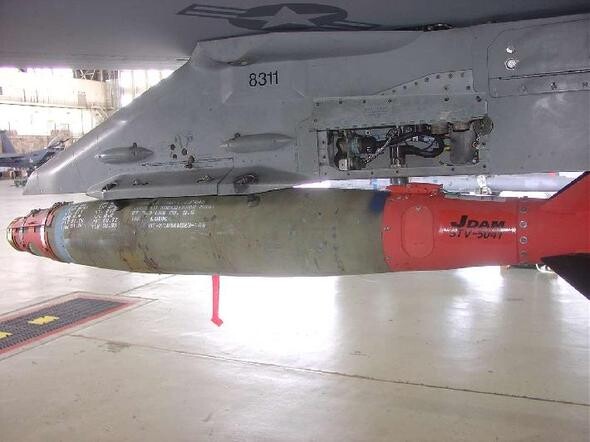hankyoreh
Links to other country sites 다른 나라 사이트 링크
Japan debating the legality of preemptive strikes on enemy bases

A series of North Korean ballistic missile launch tests toward the East Sea has prompted renewed calls in Japan for preemptive strikes against enemy bases.
Proponents of the approach argue that it is a necessary countermeasure when an imminent North Korean missile attack on Japan is predicted.
The Tokyo Shimbun newspaper reported a number of comments within the country’s ruling Liberal Democratic Party (LDP) stressing the need for preemptive strike capabilities amid North Korea’s recent ballistic missile launch and nuclear tests. In March, LDP security research commission chairman Hiroshi Imazu said Tokyo “must naturally consider striking before [the enemy] fires.”
The issue of preemptive enemy base strikes has been a topic of Japanese security policy debate for over six decades. As a preemptive measure, it would be in conflict with the overriding principle of exclusive use of armed force for defensive means, which has defined Japanese defense policy since World War II. Previously discussed merely in terms of jurisprudence, the argument emerged as a practical policy concern in 2003 when it was voiced by then-Japan Defence Agency director-general Shigeru Ishiba. Ishiba, 59, is currently regional revitalization minister and is considered a leading contender to become the country’s next prime minister.
Unlike South Korea, Japan does not have ballistic missiles of its own. To strike at an enemy base, its fighter planes would have to penetrate air defense radar and enter North Korea airspace to fire an air-to-surface guided missile or cruise missile. Currently, Japan has some ability to carry out such a strike with the laser-guided Joint Direct Attack Munition kit installed in the F-2, the leading aircraft of its Air Self-Defense Force. That ability could be beefed up if its F-35 aircraft are fitted with the Joint Air-to-Surface Standoff Missile, which the country is planning to introduce in the future.
Regarding the calls for enemy base strike capabilities, former Prime Minister Ichiro Hitoyama said at a 1956 House of Representatives cabinet meeting that “we cannot consider it the spirit of the Constitution that we should simply sit and wait for destruction in the event of a guided missile or other attack against the national territory.”
“We must assume that it is legally within the scope of self-defense to strike a base [first] with a guided missile to prevent such an attack,” he said at the time.
By Gil Yun-hyung, Tokyo correspondent
Please direct questions or comments to [english@hani.co.kr]

Editorial・opinion
![[Editorial] Does Yoon think the Korean public is wrong? [Editorial] Does Yoon think the Korean public is wrong?](https://flexible.img.hani.co.kr/flexible/normal/500/300/imgdb/original/2024/0417/8517133419684774.jpg) [Editorial] Does Yoon think the Korean public is wrong?
[Editorial] Does Yoon think the Korean public is wrong?![[Editorial] As it bolsters its alliance with US, Japan must be accountable for past [Editorial] As it bolsters its alliance with US, Japan must be accountable for past](https://flexible.img.hani.co.kr/flexible/normal/500/300/imgdb/original/2024/0417/6817133413968321.jpg) [Editorial] As it bolsters its alliance with US, Japan must be accountable for past
[Editorial] As it bolsters its alliance with US, Japan must be accountable for past- [Guest essay] Amending the Constitution is Yoon’s key to leaving office in public’s good graces
- [Editorial] 10 years on, lessons of Sewol tragedy must never be forgotten
- [Column] A death blow to Korea’s prosecutor politics
- [Correspondent’s column] The US and the end of Japanese pacifism
- [Guest essay] How Korea turned its trainee doctors into monsters
- [Guest essay] As someone who helped forge Seoul-Moscow ties, their status today troubles me
- [Editorial] Koreans sent a loud and clear message to Yoon
- [Column] In Korea’s midterm elections, it’s time for accountability
Most viewed articles
- 1[Column] The clock is ticking for Korea’s first lady
- 2Samsung barricades office as unionized workers strike for better conditions
- 3[Editorial] When the choice is kids or career, Korea will never overcome birth rate woes
- 4S. Korea, Japan reaffirm commitment to strengthening trilateral ties with US
- 5[News analysis] After elections, prosecutorial reform will likely make legislative agenda
- 6Japan officially says compensation of Korean forced laborers isn’t its responsibility
- 7Why Israel isn’t hitting Iran with immediate retaliation
- 8[Editorial] As it bolsters its alliance with US, Japan must be accountable for past
- 9[Editorial] Does Yoon think the Korean public is wrong?
- 10[Guest essay] How Korea turned its trainee doctors into monsters